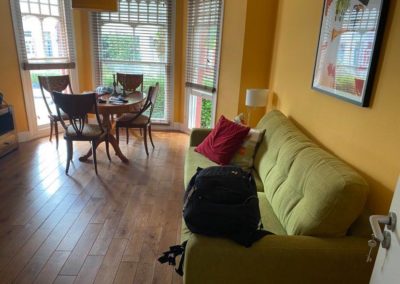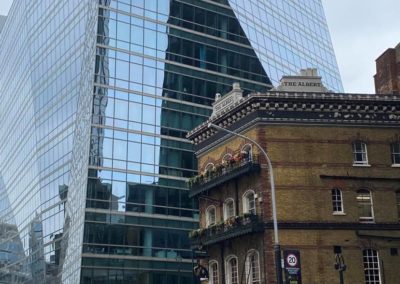I was sure I’d fall in love with London. We saw it first from the sky. Our plane flew over it just as the sun was coming up. Below us the Thames bisected the city and the iconic landmarks were easily recognizable.
My mum lived in London as a young woman before the war, and she loved it. It was certainly more exciting than sleepy Vancouver. From being an only child in a very conventional household, she went to London to stay with her free-thinking Uncle Bruce and Aunt Elspeth and their seven rowdy and independent daughters.
Her father, my Gagadaddy, began reading Dickens to me when I was five, sitting on his knee by the fire. I’ve been fascinated by the evolution of the city from its earliest incarnation through its rebuilding after the Blitz. In the Eurocentric history I grew up studying, London was the hub around which western culture developed. All my life I’ve read books and watched movies set in London, and I couldn’t wait to finally see it.
The thing is, I didn’t love it. Or at least, not at first.
London is incredibly noisy, louder, it seems to me, than New York. Perhaps because we’d come into town after a week in the Devon countryside – and after a year of seclusion in Austin – I felt disoriented by the streets full of cars, bicycles, cabs and busses and the crush of people hurrying along the sidewalks. There was a period of adjustment.
After a few days, however, the city had its way with me. I love the juxtaposition of ancient buildings, some dating from the 11th Century, and ultramodern skyscrapers. The contemporary architecture is imaginative and playful.
I love the people. Most everyone we encountered was friendly and welcoming. I love the diversity. The apartment we rented was in Hackney, an area Dempsey said reminded him of parts of Brooklyn. There is a large community of Hasidic Jews. I was fascinated by the elaborate dress of some of the men, many of whom wore fur hats reminiscent of 19th Century Russia.
The men generally ignored us, but helped their wives shepherd their large families through the streets. The women were friendly. They were dressed fashionably but modestly, heads covered with wigs or hats. The little girls wore charming embroidered dresses and tights.
There were many people of Asian and South Asian descent, and many of Middle Eastern backgrounds. There were women dressed in every flavor of hijab, from burkas to loose scarfs.
Our landlords were Central American, and there were a number of black people. Dempsey had a lot of opportunity to practice what I call the “bro greeting,” a small salute exchanged among middle-aged black men as they pass on the street. I tell Dempsey I think of it as a sort of “Namaste”: the mature black man in me recognizes and honors the mature black man in you.
We met a black man in his twenties who is a tour guide. Like many of the people we encountered, he was fascinated with America and interested in traveling there. He’d made one trip to New York, and was struck by how segregated the city is. In London he lived among and went to school with people of many ethnicities. He’d also been following American news, and he wondered if he’d be safe in the U.S. We assured him it’s well worth visiting, and it’s likely he’d be safe wherever he traveled. I felt sad seeing our image reflected back, and knowing there is at least some truth in his concerns.
The growing diversity of the city is reflected in many ways. Our first outing was to the Tate Britain, which houses British art from the 1500s through the present day. They have a diversity committee to weigh in on the displays, which now include a wide variety of art made by and featuring women and artists of color. Reading the descriptions reminded me again of how our perception of culture, like history, is influenced by what we are shown.
We visited Buckingham Palace and the nearby parks. Like every place we’ve been in England, the parks are green and bursting with flowers. I saw Hyde Park Corner, where for hundreds of years people have stood and spoken their beliefs, some of them quixotic but many eventually accepted. Women spoke there on behalf of suffrage.
There’s no Hyde Park corner in Texas. But the times I marched in college for Civil Rights and against bombing Cambodia, the times I stood on the steps of the Capitol and spoke out against American military intervention in the Middle East, when I lay down within a chalk outline on Congress Avenue to demonstrate lives lost, or protested the use of capital punishment, my activism was informed by the stories of those passionate speakers.
My favorite tour was on a boat down the Thames, which provided a panoramic view of Winchester Cathedral, Parliament and Big Ben, the London Eye and all the bridges. It was an eye level view of what we’d seen from the plane.
In the end, it was difficult to leave London, but we wanted to explore more of the U.K. I know I will be back. It would require months to take in everything there is to see in the city, and a year to begin to see all this beautiful country.












0 Comments